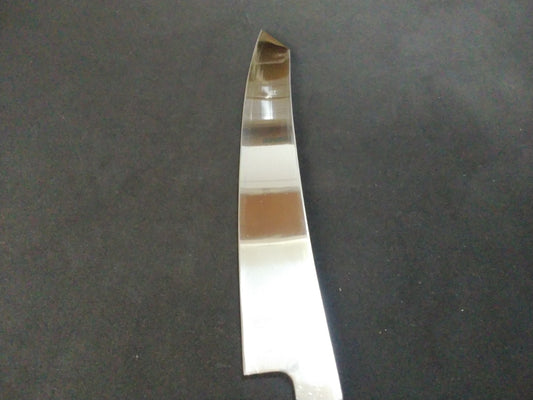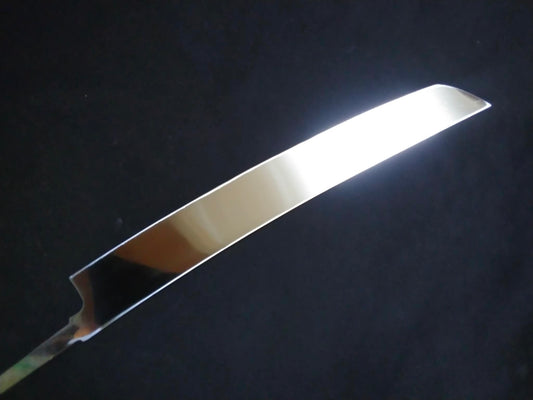
Damascus Steel
-
-
What Is “Damascus Steel”?
The Truth Behind the Legendary Beauty of Its Wavy Patterns
-
Knives and swords adorned with graceful, flowing wave-like patterns instantly evoke one word: “Damascus steel.” Yet, what many may not realize is that “Damascus” is not the name of a material, but rather the name of a unique pattern itself.
-
Centuries ago, in the ancient city of Damascus (modern-day Syria), master craftsmen worked with a rare and precious steel called Wootz steel. This steel’s special composition naturally created mesmerizing ripple patterns during the forging process. The blades forged from Wootz steel were not only breathtakingly beautiful but also exceptionally strong and resilient—so prized that warriors across the world sought after these legendary weapons. Over time, they became known as “Damascus steel.”
-

However, true Wootz steel is now lost to history. The specific ores and the forging secrets required to recreate it have vanished, making the original Damascus steel an unattainable and mythical material of the past.
-
So, what does “Damascus steel” mean today?
-
Modern artisans recreate the iconic wave patterns by skillfully layering and forging together steels of varying hardness and carbon content. This traditional forging technique is no longer just a method of production but has evolved into a symbol of exquisite craftsmanship and timeless beauty. Every blade tells a unique story, with each pattern as individual as a fingerprint.
-
Today’s Damascus knives are more than mere tools; they are works of art where form meets function. Above all, they carry a silent tribute to a lost legend—a spirit that lives on in every swirl and wave of the blade.
-
By understanding not only the appearance but the deep meaning and history behind these patterns, you can appreciate Damascus steel on a profoundly richer level—as a fusion of heritage and artistry, forged into a single blade.
Meet the Traditional Craftsmen Behind the Technique

Forging
Shogo Yamatsuka
A master blacksmith renowned for his exceptional skill in forging Ginsan steel—a rarity in Sakai. Certified as a Traditional Craftsman in 2012, he is trusted by professional chefs for overseeing every step of knife-making, including final sharpening, with unwavering precision.

Sharpening
Tadayoshi Yamatsuka
Certified as a Traditional Craftsman in 2022, Mr. Yamatsuka is highly regarded in Sakai for his exceptional mirror-polishing skills. His beautifully finished blades continue to captivate chefs both in Japan and around the world.
Damascus Steel Knife Collection
-
Ginsan Damascus Yanagiba(Kiritsuke) 270mm -Mirror Polished(both sides)
Regular price $740.00 CADRegular priceUnit price / per$0.00 CADSale price $740.00 CAD -
Ginsan Damascus Yanagiba(Sakimaru) 300mm -Mirror Polished(both sides)
Regular price $810.00 CADRegular priceUnit price / per$0.00 CADSale price $810.00 CAD -
Ginsan Damascus Yanagiba(Sakimaru) 400mm-Mirror Polished(both sides)
Regular price $1,180.00 CADRegular priceUnit price / per$0.00 CADSale price $1,180.00 CAD
KIREAJI's Three Promises to You
-

1. Exceptional Japanese Knives
Our knives, crafted by Sakai City's master artisans, combine traditional techniques with carefully selected materials, delivering unrivaled sharpness and durability.
-

2. For a Lifetime of Use
At KIREAJI, we see knives as lifelong companions. Each knife comes with a free saya, and we offer Honbazuke hand-sharpening by Shiroyama Knife Workshop in Sakai City.
-

3. Supporting the Joy of Continued Use
KIREAJI knives are made to grow with you. That’s why we provide trusted after-sales care (fee-based) .
Features of Damascus Steel
-

Beautiful pattern
Damascus steel is renowned for its distinctive patterns created by layering or folding different types of steel. This process results in a striking pattern throughout the blade, giving it a luxurious and elegant finish.
-

High hardness
The forging process of Damascus steel involves layering various types of steel, which increases its hardness. This technique creates a fine crystalline structure inside the blade, enhancing its strength and durability.
-

Durability
The layering in Damascus steel not only boosts its strength but also its durability. The forging process helps remove impurities and air bubbles, resulting in a blade that is highly resistant to wear and corrosion.

Sakai Knives: Each One Unique, Handcrafted by Master Artisans
Each knife is handcrafted, maEvery Sakai knife is born from the hands of master artisans,Each stroke infused with soul and centuries of tradition.No two blades are ever the same –Your unique Sakai knife awaits, the only one of its kind in the world.king it a one-of-a-kind piece that exists nowhere else in the world.
Caring for Your Damascus Knife: Preserving Its Beauty and Performance
-
A Damascus knife is more than just a kitchen tool—it’s a piece of art that elevates the cooking experience. Its stunning layered patterns can spark joy and inspire confidence, turning every meal preparation into something special. Just holding a Damascus knife can make you feel excited or focused, setting the tone for your cooking.
To maintain this beauty and ensure its sharp performance, proper care is essential. By learning the right techniques, you can keep your knife in excellent condition for years to come.
-
Care Instructions After Use
- Wash Immediately
After use, gently clean your knife with a soft sponge and neutral detergent. Leaving dirt on the blade can make it harder to clean and may lead to rust. - Rinse with Hot Water
Pour hot water over the blade to help evaporate moisture. This simple step can reduce the risk of rust forming. - Dry Thoroughly
Use a cloth or paper towel to carefully dry your knife, ensuring no moisture is left behind. A final thorough wipe will enhance its shine.
- Wash Immediately
-

Sharpening Tips
When sharpening your Damascus knife, it’s crucial to protect its beautiful layered pattern. Sharpening the entire blade on a whetstone can make the pattern fade over time.
While this does not affect the knife’s cutting performance, to preserve its appearance, it is recommended to sharpen only the edge. This way, you maintain the knife’s stunning design while keeping its blade sharp and effective.
-
The Joy of Owning a Damascus Knife
A Damascus knife thrives on consistent care. Every small effort you put into maintaining it will keep it shining and performing at its best. There’s something deeply rewarding about taking care of a favorite tool, knowing it will serve you beautifully in return.
-
With proper care, your Damascus knife becomes a partner in your cooking journey, reflecting both its craftsmanship and your attention to detail. Let its unique patterns and razor-sharp edge inspire you to create exceptional meals, time and time again.
FAQ About Damascus Steel

What makes Damascus steel so remarkable?
The allure of Damascus steel lies in its unique wave patterns, exceptional sharpness, and high durability. The patterns, formed by forging multiple layers of metal together, are distinct and imbue the product with artistic value.
What are the drawbacks of Damascus steel?
The beautiful Damascus pattern knives tend to incur higher manufacturing costs, which can be a disadvantage for those who prioritize functionality over design, leading to increased prices. Additionally, sharpening the knife may diminish the visibility of the Damascus pattern. This isn't due to the layers disappearing but rather because the polishing process can make the wave patterns less pronounced.
Why is the pattern on the knife called "Damascus"?
The term "Damascus" pattern on knives originates from the blade patterns seen on weapons made in the Damascus region in ancient times. The formation of Damascus patterns is attributed to the lower metallurgical technology of the era, which was less capable of producing metals with fewer impurities. As the molten metal cooled and solidified, the various impurities within created unevenness, leading to the distinctive Damascus patterns.
Where does the Damascus knife originate?
The origin of Damascus steel, also known as Wootz steel, is ancient India.

The Origin of Craftsmanship
-
Embracing the Uniqueness of Damascus Knives
A Damascus knife is not just a tool; it is a work of art, forged to be one of a kind. The intricate patterns adorning its blade are the result of master craftsmanship, ensuring that no two knives are ever the same. This makes each piece a personal treasure, created exclusively for you. Beyond its beauty, it becomes an enduring companion in the kitchen, turning everyday cooking into a celebration of uniqueness and quality. Why not make every slice a moment to cherish?
-
Caution and Authenticity: Beware of Imitations
The market is flooded with imitations that mimic the appearance of real Damascus steel. At KIREAJI, Damascus steel knives are authentically made by traditional craftsmen in Sakai City.














